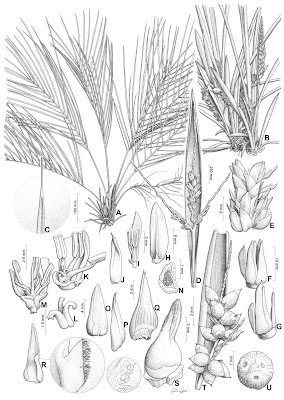 |
| Syagrus carvalhoi B.F.Sant’Anna-Santos, in Sant'Anna-Santos, Micheli, Carvalho et Soffiatti, 2023. |
Abstract
Background and aims – This study is part of ongoing research on the Arecaceae Flora of the Serra do Cabral, an isolated massif in the southwest of the Espinhaço Range in Minas Gerais State. Because of the isolation of the massif, the area has a rich biodiversity and a high level of endemism. While searching for populations of the rare and critically endangered Syagrus cabraliensis, a new bluish-leaved palm species was discovered and it is described here.
Material and methods – The new species’ morphology is described based on field collections. The pinnae were analysed using SEM and LM cross- and longitudinal sections following default methodology. In addition, we compared the species to S. cabraliensis and provided ecological notes and a conservation status assessment.
Key results – Syagrus carvalhoi resembles S. cabraliensis but they can easily be distinguished by morphoanatomical characters. Both species occur non-sympatrically in the Serra do Cabral, in contrasting microhabitats: S. carvalhoi in the southern quartzitic campos rupestres and S. cabraliensis in the northern ferruginous campos rupestres. A key to the known grass-like Syagrus species from the massif is provided. Based on the restricted area of occurrence and the anthropogenic threats, Syagrus carvalhoi is assessed as critically endangered.
Conclusion – Syagrus carvalhoi is the second grass-like endemic Syagrus species from the Serra do Cabral and presents rare characters within the genus (grass-like aspect, colonial habit, flowers in tetrads, and the stem forking at or below the ground). This discovery corroborates that this isolated OCBIL (old, climatically-buffered, infertile landscape) is a home for endemic and rare palm species. The Serra do Cabral massif has proved a source of morphological and anatomical novelties in Arecaceae, affecting the taxonomy and understanding of the evolution and ecology of palms. Our results reinforce the notion that it is important to conserve this area with rich and rare biodiversity but under alarming and unprecedented threats.
Keywords: campos rupestres, grass-like leaf, Minas Gerais State, new species, Palmae, plant anatomy, Serra do Cabral, taxonomy
Syagrus carvalhoi B.F.Sant’Anna-Santos, sp. nov.
Diagnosis: Syagrus carvalhoi is similar to Syagrus cabraliensis (Noblick & Lorenzi) B.F.Sant’Anna-Santos, from which it differs by larger, taller clumps (sometimes with colonial habit); taller plants; leaves bluish and straight (vs dark green and slightly arched); pinnae inserted at various angles near the base but otherwise regularly arranged on the upper part of the leaf towards the tip (vs inserted at various angles throughout the entire rachis); pinnae with symmetric tip (vs asymmetric tip); pinnae glaucous on adaxial surface (vs pinnae glossy on adaxial surface); the presence of inconspicuous ramenta (vs without ramenta); rachillae of different sizes throughout the rachis (vs similar-sized rachillae); staminate flowers briefly pedicellate and filaments briefly connate at the base (vs staminate flowers long pedicellate and stamens with free filaments).
Etymology: The specific epithet carvalhoi is named in honour of Wellington Geraldo Oliveira Carvalho Júnior, a palm enthusiast who discovered this species. Mr Carvalho and his family have provided financial and logistical support to our research in recent years. So, our team’s discoveries were only possible thanks to his support and motivation.
Bruno Francisco Sant'Anna-Santos, Rafael Micheli, Luiz Fernando Lima Carvalho and Patrícia Soffiatti. 2023. A New Bluish-leaved Syagrus (Arecaceae) from an overlooked OCBIL in the Espinhaço Range (Brazil). Plant Ecology and Evolution. 156(2): 129-145. DOI: 10.5091/plecevo.101027





